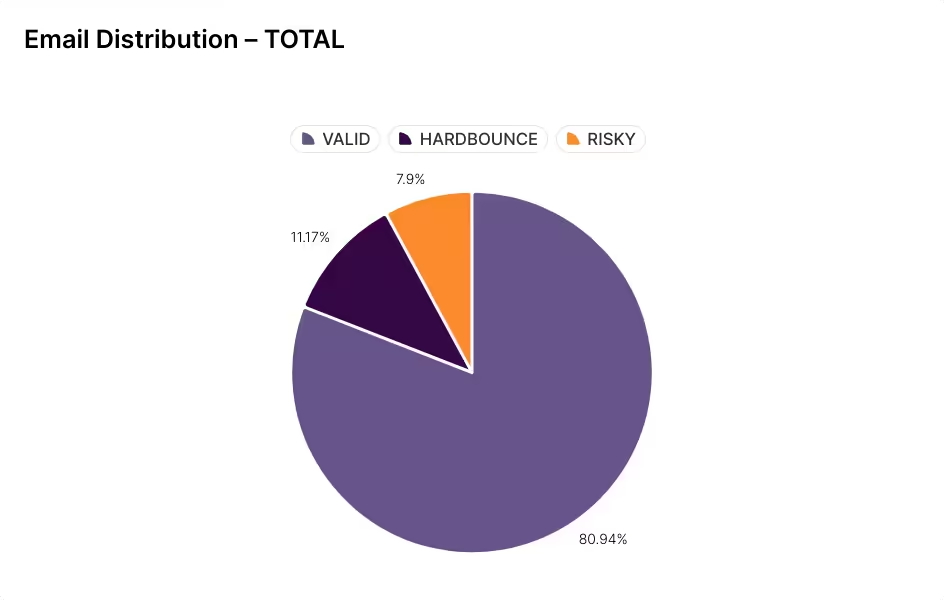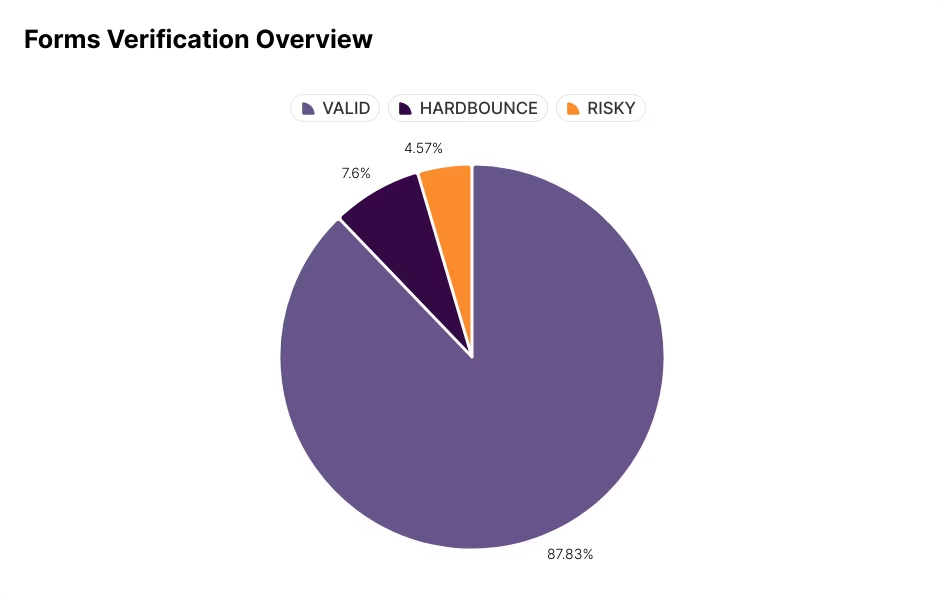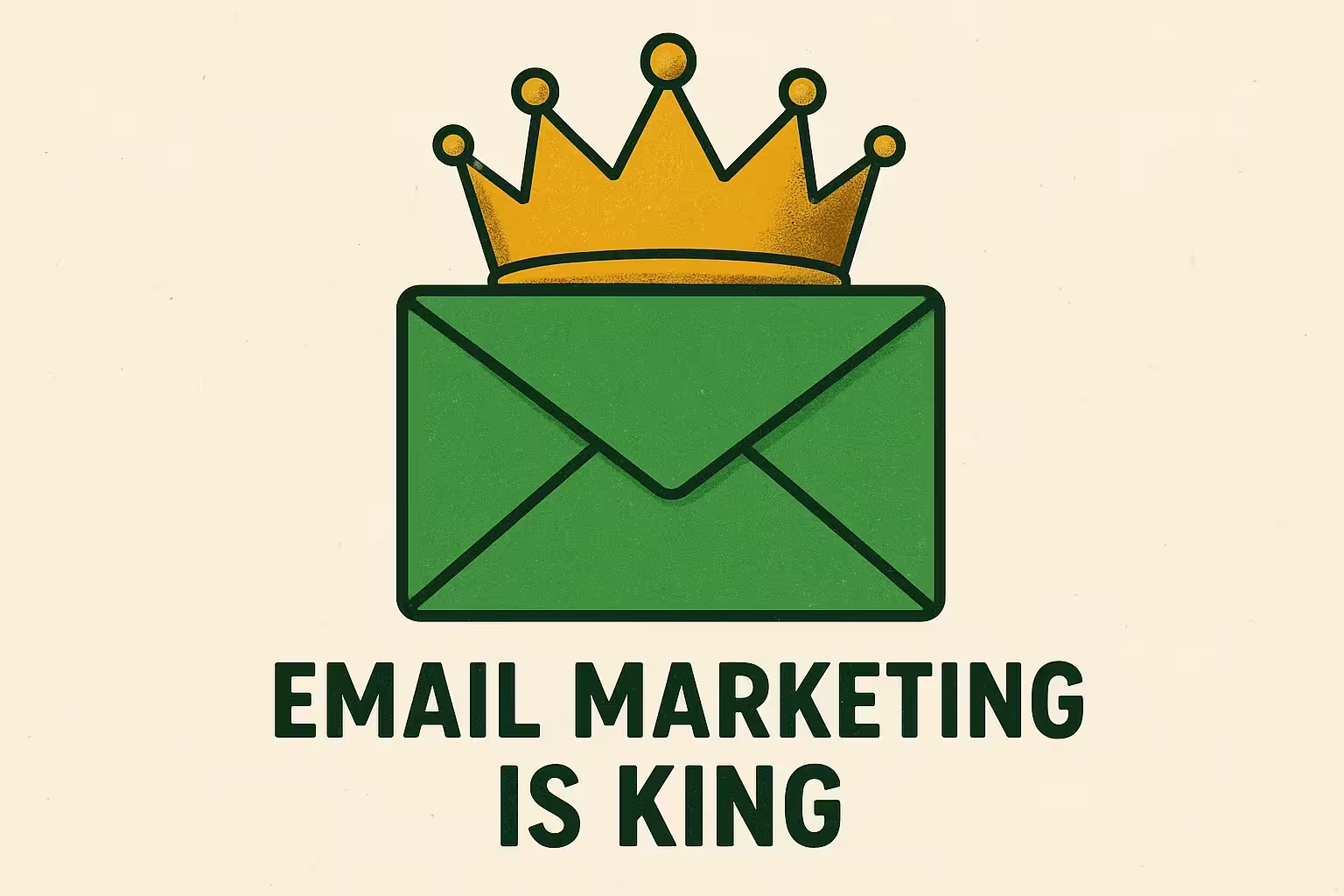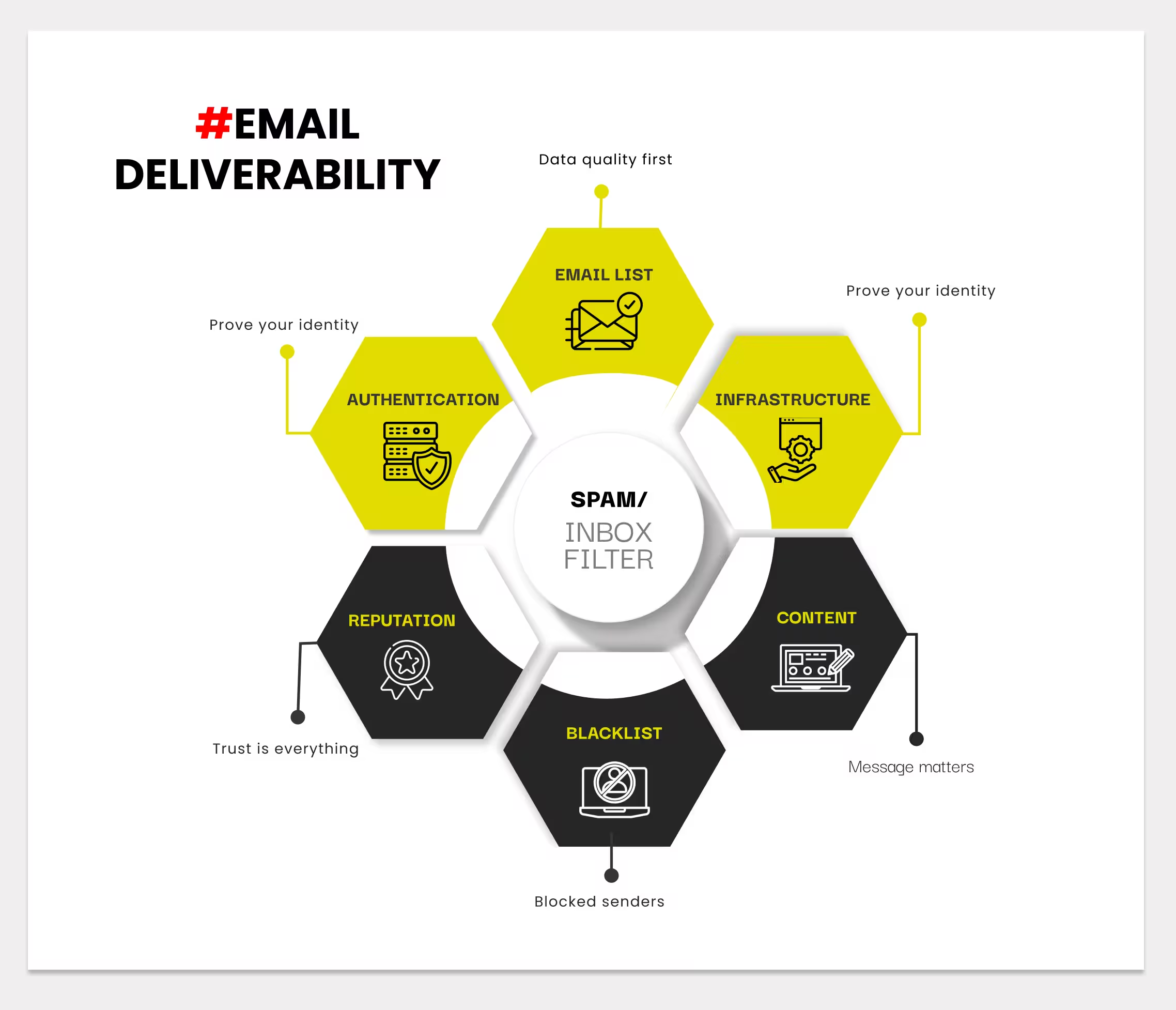Pesquisa Qualidade das Listas de Emails: Tendências e dados globais para 2025
O Relatório de Qualidade das Listas de Emails 2025, publicado pela SafetyMails, é o estudo mais aprofundado sobre a qualidade das listas de emails em todos os setores.
Esta edição analisou quase 1 bilhão de endereços de e-mail em 23 setores diferentes e vários países, mostrando como as empresas coletam, gerenciam e validam suas listas de e-mails.
Com insights sobre qualidade das listas de emails, riscos de entregabilidade de emails, bounce rates e precisão dos dados, esse relatório é um recurso essencial para profissionais de marketing, gerentes de CRM e qualquer pessoa que dependa de campanhas de email para se conectar com os clientes.
Por que você deve fazer o download do relatório completo
A edição de 2025 vai além dos números: ela fornece uma visão abrangente da qualidade das listas de emails e seu impacto direto na entregabilidade de emails e no ROI. O relatório combina referências de mercado, tendências históricas, distribuição de erros, análise de domínio e estratégias corretivas, oferecendo aos profissionais um guia prático para criar, proteger e otimizar seus bancos de dados de assinantes.
Dentro do relatório, você encontrará:
- Análise por setor: como a qualidade das listas de emails varia entre os setores, como comércio eletrônico, SaaS, finanças, saúde, turismo, educação e manufatura.
- Comparações históricas: a evolução da qualidade das listas de e-mail desde 2015, destacando as tendências e o impacto dos eventos globais.
- Distribuição de e-mails inválidos: análises detalhadas de endereços inválidos (erros de sintaxe, domínios, hard bounces) em mercados e segmentos de negócios.
- Análise de domínio: a presença e a distribuição de domínios de e-mail específicos em conjuntos de dados.
- Ações corretivas: recomendações práticas, incluindo monitoramento contínuo, remoção de duplicatas, eliminação de contatos inativos e uso de plataformas profissionais de verificação de emails.
- Análise de formulário de inscrição: dados sobre como os usuários inserem e-mails, os erros mais comuns no nível do formulário e estratégias de prevenção para impedir endereços inválidos na origem.
Principais insights sobre a qualidade das listas de emails
O relatório de 2025 mostra que a qualidade da lista continua sendo um desafio crítico para os profissionais de marketing. Embora a maioria dos endereços seja válida e segura para envio, uma parcela significativa dos contatos ainda é composta por e-mails inválidos ou arriscados. Quase um em cada cinco endereços em bancos de dados ativos pode gerar hard bounce, prejudicar a capacidade de entrega e a reputação do remetente. As descobertas também revelam que a maioria dos problemas decorre de questões básicas - usuários inexistentes, domínios inválidos e erros de sintaxe - mostrando como erros facilmente evitáveis podem comprometer o desempenho da campanha.

Algumas das descobertas mais relevantes:
- 80,94% dos e-mails são válidos e seguros para envio;
- 11,7% são inválidos, gerando hard bounces;
- 7,9% são arriscados, incluindo spamtraps e e-mails descartáveis;
- Isso significa que quase 1 em cada 5 e-mails (19,6%) pode prejudicar a entregabilidade de emails.
Detalhamento de e-mails inválidos:
- 77,76% não eram usuários (contas inexistentes);
- 14,47% tinham domínios inválidos;
- 7,77% apresentaram erros básicos de sintaxe.
O problema começa no formulário de inscrição
Não são apenas as listas de e-mail herdadas que são problemáticas. O relatório também analisou formulários de captura de leads e revelou:

- 87,82% dos e-mails digitados nos formulários eram válidos;
- No entanto, 7,6% já eram inválidos, gerando hard bounce imediatamente;
- Outros 4,57% eram arriscados, geralmente e-mails falsos ou descartáveis usados para acessar conteúdo gratuito.
Erros de formulário mais comuns:
- 47,6%: endereços inexistentes;
- 39,4%: domínios inválidos (por exemplo, "gamil" em vez de "gmail");
- 12,9%: erros de sintaxe (falta de @, vírgulas, espaços, etc.).
O mercado global de email marketing

Em um mundo de tendências em rápida mudança e canais emergentes, o email marketing continua a ser um dos pilares mais fortes da comunicação digital.
Mais de 400 bilhões de e-mails são enviados todos os dias e, somente em 2023, o mercado gerou $ 8,17 bilhões, com projeções que ultrapassam $ 27 bilhões até 2031.
Esse crescimento é impulsionado principalmente por empresas de pequeno e médio porte: 81% delas confiam no email marketing como uma estratégia-chave. E funciona - 60% dos consumidores afirmam ter feito uma compra depois de receber um e-mail promocional.
Mas com essa escala, a entregabilidade de emails se tornou o principal diferencial.
Como funciona a entregabilidade de emails
Chegar à caixa de entrada é mais do que apenas enviar um e-mail - trata-se de superar vários filtros e verificações de reputação. A entregabilidade de emails mede se suas campanhas chegam à caixa de entrada principal e não à pasta de spam.

O processo depende de fatores-chave:
- Listas de emails limpas e verificadas: a entregabilidade de emails começa com a qualidade dos dados. O envio para listas cheias de hard bounces ou e-mails arriscados (spamtraps ou descartáveis) prejudicará rapidamente sua reputação de remetente e bloqueará o posicionamento na caixa de entrada.
- Autenticação: protocolos como SPF, DKIM e DMARC confirmam que seu domínio é legítimo.
- Reputação: os ISPs (Gmail, Outlook, Yahoo) rastreiam reclamações de spam, devoluções, spamtraps e consistência de envio.
- Infraestrutura: servidores, IPs e registros MX configurados corretamente garantem uma entrega sem problemas.
- Conteúdo: linhas de assunto, texto, links e frequência afetam o posicionamento na caixa de entrada.
- Blacklists: listas públicas e privadas que identificam domínios ou IPs que enviam tráfego suspeito. Ser listado reduz a entregabilidade de emails e, muitas vezes, impede que os emails cheguem à caixa de entrada.
Práticas recomendadas para melhorar a capacidade de entrega:
- Mantenha sua lista de emails limpas usando a verificação de emails em tempo real para reduzir endereços inválidos.
- Mantenha baixas taxas de bounce rate e monitore o envolvimento (aberturas, cliques, cancelamentos de assinatura).
- Forneça um link claro para cancelar a assinatura para evitar reclamações de spam.
- Segmentar e personalizar o conteúdo para aumentar a relevância.
- Use protocolos de autenticação para proteger a identidade de seu remetente.
Apenas 3% podem arruinar o desempenho de sua lista de e-mails
Os provedores de e-mail e as plataformas de envio estão mais rigorosos do que nunca. Hoje, qualquer lista de e-mail com mais de 3% de hard bounce corre o risco de:
- Envio de blocos;
- Perda de reputação de domínio e IP;
- Estar na lista negra;
- Aterrissando direto na pasta de spam.
Valide suas listas de emails e melhore a entregabilidade de emails
Listas de e-mail sujas ou desatualizadas são a principal causa de hard bounce, blacklisting e baixo posicionamento na caixa de entrada. Com o SafetyMails, você pode validar suas listas de emails antes de cada campanha e eliminar emails inválidos, descartáveis e arriscados que prejudicam sua reputação. Ao manter sua lista limpa, você protege sua pontuação de remetente, melhora o posicionamento na caixa de entrada e garante que suas campanhas alcancem assinantes reais que se envolvem.
O que é uma lista de e-mails e por que ela é importante
Uma lista de e-mail é um conjunto de assinantes que optaram por receber suas comunicações, formando uma linha direta de comunicação entre sua marca e seu público. Ao contrário das redes sociais, em que o alcance orgânico é limitado, ou das plataformas pagas, em que a visibilidade depende dos orçamentos de publicidade, uma lista de emails é um ativo de longo prazo que você controla totalmente.
Por que é importante:
- As campanhas de e-mail mostram consistentemente o maior retorno sobre o investimento (ROI) em comparação com outros canais digitais.
- Ao contrário dos feeds sociais, em que as publicações são filtradas por algoritmos, um e-mail chega diretamente à caixa de entrada com apenas um clique no botão email.
- Com a segmentação de público e tagging adequados, você pode enviar e-mails de difusão ou campanhas direcionadas que correspondam aos interesses dos assinantes.
- Ele potencializa estratégias avançadas, como construção de lista de emails por meio de formulários de inscrição, programas de referência como o Rafflecopter e ferramentas de automação que melhoram a entregabilidade e o engajamento.
Erros e armadilhas comuns na construção de listas de emails
A construção de uma lista de emails vai além da coleta de endereços - ela requer estratégia e manutenção contínua. O relatório de emails 2025 destaca que muitas empresas ainda enfrentam problemas que comprometem o crescimento da lista e a entregabilidade de emails. Os erros frequentes incluem:
- Coleta de e-mails falsos por meio de formulários de captura de leads mal validados;
- Usar formulários de inscrição complexos que desestimulam os usuários, especialmente em dispositivos móveis;
- Falta de conformidade com as leis de opt-in de email marketing, aumentando os riscos sob o GDPR, LGPD e CCPA;
- Negligenciar a segmentação de e-mail e enviar campanhas genéricas para todos os assinantes;
- Ignorar a manutenção da lista, o que leva a altas rejeições e problemas com a pasta de spam;
- Ignorar a análise e as métricas de desempenho, perdendo oportunidades de otimizar as campanhas;
- Não aproveitar a automação ou um programa de referência para escalar o crescimento da lista de forma eficaz.
Práticas recomendadas e conformidade na construção de listas de emails
Aumentar uma lista de e-mails de forma responsável exige mais do que coletar endereços - exige práticas éticas e conformidade com as normas de privacidade. O relatório de 2025 reforça que as empresas que seguem relacionamentos baseados em permissão alcançam maior engajamento e maior capacidade de entrega.
Algumas das práticas recomendadas essenciais incluem:
- Usar formulários claros de opt-in e check-out opt-ins para coletar dados de forma transparente;
- Respeitar os padrões de opt-in de e-mail obtendo permissão explícita dos assinantes;
- Fornecer opções de cancelamento simples e visíveis para manter a confiança;
- Seguir regulamentos de email marketing como CAN-SPAM, GDPR, e CCPA para evitar penalidades e proteger a reputação de sua marca;
- Aplicação de processos estruturados de gerenciamento de listas de emails e gerenciamento de listas de contatos para garantir a qualidade contínua;
- Estabelecer parcerias com base na geração ética de leads, evitando dados adquiridos de fontes não confiáveis;
- Considerar a experiência do assinante em todos os canais, inclusive em dispositivos móveis e até mesmo em experiências de consulta virtual, para promover um envolvimento duradouro.
Otimização dos processos de inscrição e opt-in
A construção de uma forte lista de emails requer não apenas a coleta de endereços, mas a otimização de cada etapa da jornada de inscrição. O relatório de emails 2025 mostra que as empresas com processos estruturados e otimizados de opt-in obtêm conversões mais altas e lista de emails mais limpas.
Algumas práticas recomendadas incluem:
- Projetar formulários de inscrição em várias etapas com campos simples e botões CTA que sejam claros e persuasivos;
- Executar testes A/B em layouts de formulários, CTAs e posicionamentos para aumentar as taxas de conversão;
- Usar a otimização móvel e construtores de arrastar e soltar para garantir experiências tranquilas em todos os dispositivos;
- Oferecer ofertas fechadas ou depoimentos para criar confiança e incentivar opt-ins;
- Aproveitar os popups de intenção de saída e os opt-ins de e-mail pós-compra para capturar assinantes nos principais momentos de decisão;
- Implementação do double opt-in para conformidade e maior envolvimento.
Proteja seus formulários com a API do Email Checker
Cada e-mail inválido ou falso capturado na inscrição enfraquece seus resultados de marketing. O SafetyMails Email Checker API verifica cada endereço em menos de 1 segundo, bloqueando spamtraps, descartáveis e erros de digitação antes que cheguem ao seu banco de dados. Isso protege sua estratégia de geração de leads, garante que somente assinantes válidos entrem em sua lista e maximiza o ROI de cada campanha.
Ative sua avaliação e obtenha 1.000 verificações gratuitas em tempo realEstratégias para a construção e o crescimento de uma lista de emails
Expandir sua lista de e-mails não se trata apenas de capturar endereços - trata-se de atrair os assinantes certos com estratégias que maximizam o crescimento e a qualidade. O relatório de emails 2025 destaca que as empresas mais bem-sucedidas combinam criatividade, tecnologia e verificação de emails para construir listas sustentáveis.
Algumas estratégias comprovadas incluem:
- Oferecer valiosos ímãs de leads (guias, modelos, descontos) em troca de inscrições verificadas;
- Realizar concursos e brindes com regras claras de adesão para atrair participantes engajados;
- Criação de landing pages otimizadas com formulários de inscrição robustos, testados por meio de testes A/B;
- Usar popups interativos, incentivos de indicação e ofertas sociais exclusivas para capturar novos assinantes;
- Aproveitamento de públicos semelhantes e campanhas pagas para alcançar leads potenciais de alta qualidade;
- Criação de sequências automatizadas de boas-vindas que iniciam relacionamentos imediatamente após o cadastro;
- Usar a segmentação desde a primeira interação para fornecer conteúdo personalizado.
Engajamento e conteúdo para assinantes de e-mail
Uma lista de e-mail crescente só tem valor quando os assinantes permanecem engajados. O relatório de 2025 destaca que as empresas bem-sucedidas vão além da aquisição, concentrando-se em fornecer conteúdo exclusivo e manter a relevância por meio da personalização e da automação.
Algumas estratégias eficazes de engajamento incluem:
- Criar sequências automatizadas de autorrespostas e e-mails de boas-vindas para criar confiança inicial;
- Envio de e-mails de difusão direcionados com o suporte da segmentação de engajamento (por exemplo, usuários ativos versus inativos);
- Usar ferramentas de automação de e-mail e software de email marketing para personalizar campanhas em escala;
- Oferecer ímãs de leads baseados em valor e até produtos de marca conjunta para fortalecer os relacionamentos;
- Aplicação de métricas de engajamento e de um sistema de pontos para classificar a atividade do assinante e adaptar as mensagens;
- Fornecer links de cancelamento de assinatura claros e acessíveis para criar confiança e cumprir os regulamentos;
- Fornecimento de conteúdo personalizado que se adapta às preferências e aos comportamentos do usuário.
SafetyMails: uma autoridade global em verificação de emails
A SafetyMails é especializada em verificação de emails em massa e em tempo real, ajudando empresas em todo o mundo:
- Reduzir bounce rates em até 98%;
- Proteger a reputação do domínio e do IP;
- Melhore a entregabilidade de emails e as conversões;
- Integrar a verificação em CRMs, formulários e plataformas de marketing.
Mais de 10.000 empresas em todo o mundo confiam no SafetyMails para manter suas listas de emails seguras, válidas e lucrativas.
Faça o download do relatório gratuito agora
Não deixe que dados ruins comprometam seus resultados.
Faça o download do Relatório de Qualidade das Listas de Emails 2025 e descubra como melhorar suas campanhas com listas de emails limpas, verificadas e confiáveis.